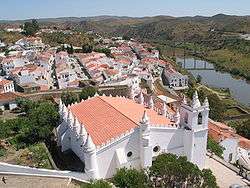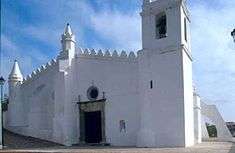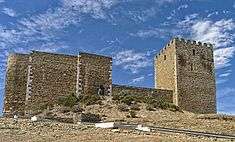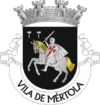Mértola
| Mértola | |||
|---|---|---|---|
| Municipality | |||
| |||
 | |||
| Coordinates: 37°38′25″N 7°39′40″W / 37.64028°N 7.66111°WCoordinates: 37°38′25″N 7°39′40″W / 37.64028°N 7.66111°W | |||
| Country |
| ||
| Region | Alentejo | ||
| Subregion | Baixo Alentejo | ||
| Intermunic. comm. | Baixo Alentejo | ||
| District | Beja | ||
| Parishes | 7 | ||
| Government | |||
| • President | Jorge Rosa (PS) | ||
| Area | |||
| • Total | 1,292.87 km2 (499.18 sq mi) | ||
| Population (2011) | |||
| • Total | 7,274 | ||
| • Density | 5.6/km2 (15/sq mi) | ||
| Time zone | WET/WEST (UTC+0/+1) | ||
| Website | Official website | ||
Mértola (Portuguese pronunciation: [ˈmɛɾtulɐ]) is a town and a municipality in southeastern Portugal next to the Spanish border. The population in 2011 was 7,274,[1] in an area of 1292.87 km².[2] In terms of land area, it is the sixth-largest municipality in Portugal. The resultant population density of 5.62 persons/km² is the second-lowest in Portugal, behind only that of adjacent Alcoutim. The municipality is located in the southeastern part of Beja District, in the Lower Alentejo region.
The seat of the municipality is the town of Mértola, which has around 2800 inhabitants (2011). The town of Mértola is located on a hill by the Guadiana River, and its strategic location made it an important fluvial commercial port from Classical Antiquity through the period of Islamic domination. Among the vestiges of its past, Mértola's main church (Igreja de Nossa Senhora da Anunciação) was the only medieval mosque to have survived in Portugal.
The present Mayor is Jorge Rosa, elected by the Socialist Party.
History
Origins

During Classical Antiquity, Mértola was inhabited by Phoenicians, Carthaginians and finally the Romans, who called it Myrtilis Iulia. The strategic location of Mértola, on a hill by the northernmost navigable part of the Guadiana river, was crucial in its early development. Agricultural products grown in the villae nearby and valuable minerals (silver, gold and tin) obtained from the lower Alentejo region were sent from the fluvial port of Mértola via the Guadiana to Southern Hispania and the Mediterranean. The town was raised to the status of a Municipium in times of Emperor Augustus and was connected to important Roman cities (Beja, Évora) through a road system.
During the Migration Period, Mértola was invaded by Germanic tribes of the Sueves and the Visigoths. In this period (5th-8th centuries) commerce was reduced but still active, as evidenced by Greek tombstones from the 6th-7th centuries found in Mértola which suggest the presence of Byzantine merchants in the town.
Islamic rule
Around the year 711, Hispania was invaded by the Moors from the Maghreb, inaugurating a period of great influence of Islamic culture in the Alentejo region that would last nearly 500 years. Mértola - then called Martulah - and its port played an important economic role in the commerce of agricultural and mineral goods between the Alentejo and other parts of Al-Andalus (Arab Hispania) and Northern Africa.
Mértola had a wall dating from Roman times, but the Muslims built new fortifications and, eventually, a castle to protect it from rival Muslim and Christian states. After the fall of the Caliphate of Córdoba, in 1031, Mértola became an independent taifa state, until it was conquered by the taifa of Seville in 1044-1045. Between 1144 and 1150 the town was again seat of an independent state led by Ibn Qasi, a mystic and skilled military leader who unified Southern Portugal and fought the power of the Almoravides. The independence of the region, however, was soon ended by an invading Almohad army. The most important remnant from the Islamic period of Mértola is its mosque, built in the second half of the 12th century and later turned into a church, but which still preserves many of its original characteristics.
Reconquista
In 1238, in the context of the Reconquista, the town was conquered by Portuguese King Sancho II, putting an end on centuries of Islamic domination in the Mértola region. The town was donated to the Knights of the Order of Santiago, a Military Order that played a vital role in the Christian conquest of Southern Portugal. The seat of the Order was established in Mértola until 1316. From the Reconquista time date most of the castle, including its mighty keep, and a letter of feudal rights (foral), granted in 1254.
With the ties with Northern Africa severed, the economic importance of Mértola and the Guadiana faded after the Reconquista. In the 15th-16th centuries, when the Portuguese conquered several cities in the Maghreb, Mértola experienced a brief revival in its economic relevance, supplying Portuguese troops in Northern Africa with cereals. King Manuel I granted a new foral to the town in 1512.
Modern era
After a long period of economic stagnation, the discovery of copper in the S. Domingos mines led to a new wave of development that would end abruptly in 1965, when the mine was exhausted. In the next decades, the municipality lost much of its population, who emigrated to richer parts of Portugal and other European countries. Starting in the 1980s, a series of archaeological surveys brought to light various remnants of past periods of Mértola, and the town became an important cultural touristic site.

Main sights

- The castle of Mértola, located on the highest point of the town. Even though the castle is of Muslim origin, the current building dates from a reconstruction carried out by the knights of the Order of Saint James of the Sword after the town was taken by the Christians. The most notable feature of the castle is its 30-metre-high keep tower, finished around 1292, which has an inner hall covered with Gothic vaulting. The defences include a city wall, which still encircles the town.
- Main church (the Matriz), originally a mosque built between the 12th and 13th centuries. After the Christian conquest of the town, in 1238, the mosque was turned into a church, but its architectonic structure was left unaltered. In the 16th century the church was partially remodelled, gaining Manueline vaulting with a new roof and a new main portal in Renaissance style. Nevertheless, the inner arrangement of the naves of the church, with four naves and several columns, strongly resembles that of the original mosque, and the interior of the church still has the mihrab, the decorated niche that indicates the direction of the Mecca. Outside, the church has four portals with horseshoe arches, typical of Islamic architecture.
- The museum of Mértola, consisting mostly of archaeological findings and excavations, with collections distributed all over the town. The nucleus of Islamic art in the museum is the most important in Portugal. It consists of various objects (pottery, glassware, metalwork, coins) dating from the period of Islamic domination. The collection is housed in the old cellars of the noblemen of the House of Braganza. Other exhibits include remnants of an ancient Christian church, of the basilica type, with an active cult lasting from the 5th to the 8th century. It has a large collection of palaeochristian tombstones with inscriptions; and excavations of a Roman house found under the Municipality building.
Parishes
Administratively, the municipality is divided into 7 civil parishes (freguesias):[3]
- Alcaria Ruiva
- Corte do Pinto
- Espírito Santo
- Mértola
- Santana de Cambas
- São João dos Caldeireiros
- São Miguel do Pinheiro, São Pedro de Solis e São Sebastião dos Carros
Population
| Population of Mértola Municipality (1801 – 2011) | |||||||||
|---|---|---|---|---|---|---|---|---|---|
| 1801 | 1849 | 1900 | 1930 | 1960 | 1981 | 1991 | 2001 | 2004 | 2011 |
| 9617 | 10757 | 18910 | 26310 | 26026 | 11693 | 9805 | 8712 | 7996 | 7274 |
References
- ↑ Instituto Nacional de Estatística
- ↑ Direção-Geral do Território
- ↑ Diário da República. "Law nr. 11-A/2013, page 552 70" (pdf) (in Portuguese). Retrieved 28 July 2014.

